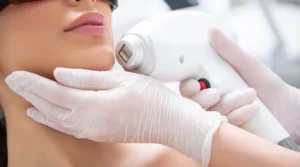Key Takeaway:
- Laser hair removal is a gradual process, not a one-time fix. Following through with multiple treatments is necessary to achieve smooth, hair-free skin. Missing appointments or not completing your treatment plan will result in incomplete hair removal.
- Make it a priority to attend every scheduled treatment, even if you notice reduced hair growth. Consistency is crucial to ensure that all hair follicles are treated, giving you the smooth results you want.
- Shaving before each session is crucial for optimal results. Avoid waxing, plucking, or using hair removal creams that could remove the hair follicle from the skin.
- Laser hair removal is a convenient and effective way to eliminate unwanted hair, but it requires commitment and proper care. With the correct number of treatments, attention to pre- and post-care, and sun protection, you’ll be well on your way to achieving smooth, long-lasting results. Always follow your technician’s advice, stay consistent with your appointments, and protect your skin from sun exposure.
Are you tired of the never-ending cycle of shaving, waxing, or plucking to achieve smooth, hair-free skin? If so, laser hair removal might be the solution you’re looking for. This increasingly popular procedure offers a long-term answer to unwanted body hair, saving time and effort. However, you should follow specific tips and tricks to maximize your laser hair removal experience for the best results.
Whether you’re considering your first session or already undergoing treatments, understanding the nuances of the procedure is essential for success. In this guide, we’ll cover four secrets to achieving optimal results from laser hair removal.
1. People Need More Than One Treatment
One common misconception is that a single laser treatment will be enough to remove hair permanently. In reality, laser hair removal is a process that requires multiple sessions for effective results. But why?
Our body hair goes through three distinct growth phases:
- Anagen (active growth phase)
- Catagen (transitional phase)
- Telogen (resting phase)
Laser hair removal is most effective during the anagen phase when the hair is actively growing. Since not all hair follicles are in the same phase simultaneously, you’ll need several sessions to target all the follicles during their growth phase. Typically, treatments are spaced 4 to 8 weeks apart, depending on the area being treated.
Why Does It Take So Long?
The 18-month treatment plan is based on the natural cycle of hair growth. This timeline allows enough time for all hair in the targeted area to cycle through the anagen phase and be effectively treated. Most people need between 6 and 12 sessions for complete hair removal.
2. Treatments Are Quick, but Consistency Is Key
One of the best things about laser hair removal is how quick the appointments are. Depending on the area being treated, sessions can last as little as 5 minutes or up to 25 minutes for larger areas like the legs or back.
Despite the short appointment times, you must attend all your scheduled sessions. Life can get busy, and skipping an appointment is easy if you’re already seeing a hair reduction. However, missing treatments can significantly slow down your progress.
Why Skipping Sessions Hurts Your Results:
As mentioned earlier, laser hair removal is most effective during hair growth. If you miss a session, you may miss the opportunity to treat follicles that have entered the anagen phase, delaying your overall progress.
3. Shave the Treatment Area Before Each Session
One critical but often overlooked step before laser hair removal is shaving the area that will be treated. Many people think that longer hair will give the laser more to “grab onto,” but the opposite is true. The laser targets the pigment in the hair follicle, not the hair itself.
Why Shaving Is Necessary:
If hair is visible on the skin’s surface, the laser can burn it instead of reaching the follicle, causing discomfort and potentially damaging your skin. Shaving ensures the laser can go directly to the follicle, maximizing its effectiveness. Make sure to shave 24 hours before your appointment to allow any skin irritation from shaving to subside.
Discover which method is right for you! Book a consultation today and start your journey to smoother, low-maintenance skin.
What About Waxing or Plucking?
Before starting laser treatments, you should avoid waxing or plucking the area for at least 4 to 6 weeks. Waxing and plucking remove the hair from the follicle, which is exactly what the laser needs to target. The treatment won’t be effective if there’s no hair in the follicle.
4. Stay Out of the Sun
Laser hair removal and sun exposure don’t mix well. To prevent complications, you would help if you avoid prolonged sun exposure before and after your complications. Why? Lasers target the pigment in hair follicles, and tanning increases the pigment in your skin, making it more difficult for the laser to distinguish between the skin and the hair.
Why Sun Exposure Can Be Dangerous:
If your skin is tanned or sunburned, the laser may target the pigment in your skin instead of the hair follicle, leading to side effects like burns, blisters, or hyperpigmentation. For this reason, your technician may have to delay your treatment if you’ve been sunburned or tanned recently.
Protect Your Skin:
Wearing sunblock with zinc oxide is essential to protect your skin. Mineral-based sunscreens offer broader and longer-lasting protection against UV rays. For the best results, use a broad-spectrum SPF 30 or higher sunscreen.
You must reschedule if you get a sunburn or tan within 14 days of your appointment. It’s also a good idea to avoid using tanning beds or self-tanning products during your treatment plan.
FAQ: Laser Hair Removal
1. Does laser hair removal work on all skin tones and hair colors?
Laser hair removal is most effective on light skin and dark hair. Newer technologies can treat a broader range of skin tones, but the laser may not be as effective on lighter hair colors, such as blond, red, or gray.
2. Is laser hair removal painful?
Laser hair removal is generally well-tolerated, with most people describing the sensation as a light snapping or pinching. Some body areas are more sensitive than others, but modern lasers often include cooling mechanisms to minimize discomfort.
3. How long do the results last?
Once you’ve completed your entire course of treatments, results can last for years. However, some people may need maintenance sessions once a year to keep the treated area hair-free, especially in hormone-sensitive areas.
4. Can I shave between laser treatments?
You can shave between treatments, but you should avoid waxing or plucking the area. Shaving doesn’t affect the follicle, so it’s safe to do while undergoing laser treatments.
5. Are there any side effects?
The most common side effects are temporary redness and swelling at the treatment site, which usually subsides within a few hours. More severe side effects, like blistering or hyperpigmentation, are rare and often avoidable by following your technician’s pre- and post-treatment instructions.
6. How do I prepare for laser hair removal?
You should shave the treatment area 24 hours before your appointment, avoid sun exposure for at least two weeks, and refrain from using any skincare products with retinol or acids in the treatment area
For more information or to begin your laser hair removal journey, visit Bergen County Hair Removal, where our certified technicians use state-of-the-art laser technology to provide the most comfortable and effective treatments.





